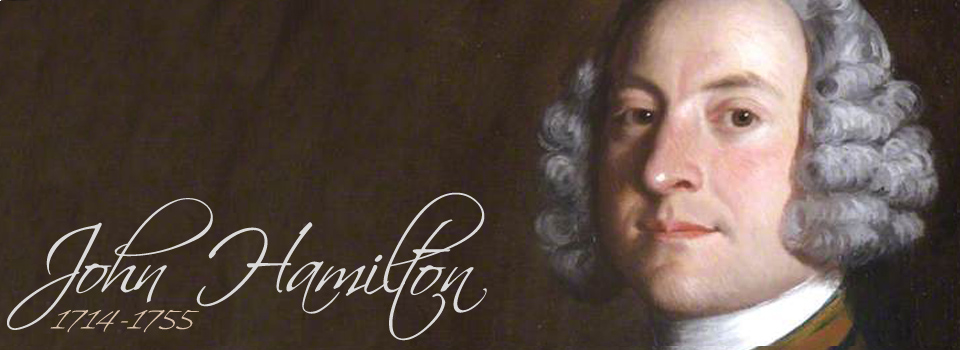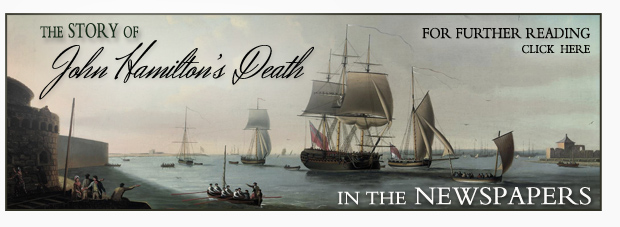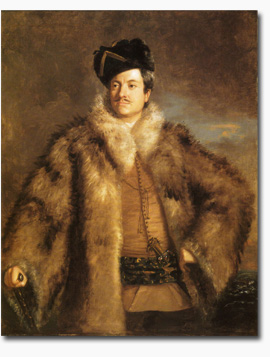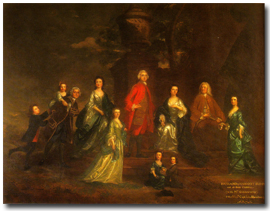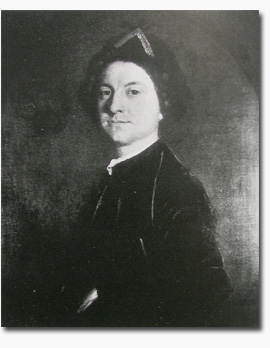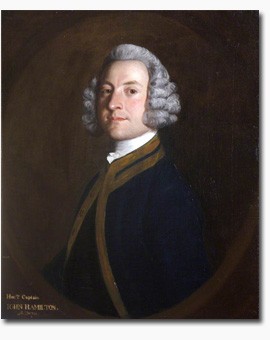Capt. John Hamilton, R.N. (1714 - 1755)
John was the second child and second son of James Hamilton (7th Earl of Abercorn) and Anne Plumer.
Captain John Hamilton is best remembered today as the subject of one of Sir Joshua Reynolds' most renowned paintings, as well as for his appearance in the Eliot Family group portrait by the same artist. During his lifetime, he was genuinely respected by people across the country as a devout Christian man of honour.
John Hamilton was born on 02 Mar 1714 to the Earl and his Lady, and (as was common for second sons) was raised to enter the Royal Navy. The young Lieutenant Hamilton was assigned to the Louisa, a ship which was wrecked (during a storm in December 1736) while sailing as escort to another bearing the king of England, George II. At the time of the disaster, the courageous Lieutenant Hamilton was the last man to leave the ship. In recognition of his gallant actions, he was presented to, and received by, the King. Queen Caroline also publicly complimented John's father on his son's gallant behaviour. For the next several years, John served in Guinea and the West Indies, receiving his promotion to the rank of Captain on 19 Feb 1740/41.
For many years, John Hamilton was a close friend of Richard and Harriot Eliot. He spent quite a lot of time at Port Eliot, visited the family at their house on Jermyn-street in London, and was actually included in the Reynolds family-group portrait of 1746. Hamilton was in command of the Augusta at this time, and the Eliot's young son sailed with him, serving as Captain's Servant and Midshipman. Sadly, while at port in Kinsale (Ireland), young Dick was taken by a sudden fever, and Hamilton shouldered the duty of burying this favorite son of his dear friends before returning to England and the bereaved family.
Not two years later (in November 1748), Captain Hamilton would again be called on to comfort the Eliot family, as they grieved for the loss of an excellent husband and father. The Captain "fixed himself in the neighborhood" in Cornwall, offering his services to the family in whatever way they needed. Almost a year later, in October 1749, he wrote to Harriot Eliot, making "an offer of himself and fortune unreservedly devoted" to her and her children's service. His offer was happily accepted, and the license was granted on November 17th. Three days later, on the twentieth, John and Harriot went to the parish church of Holy Trinity in Cookham (co. Berkshire), and were married by the groom's brother, the Rev. George Hamilton.
While the records are silent about the 35-year-old Captain's service during the first year or so of his marriage to Harriot, he is shown on a 1751 list as retiring to a peace-time half pay, which provided him with plenty of time to devote to his new family. They lived, for the most part, in Essex (making visits to Port Eliot and London), and Harriot and John's first child, Anne, was born during this time. Hamilton proved himself to be a good father to the children who already knew him as a friend of their parents. The younger Eliot children would have had more memories of him than their own father, and personal items from Hamilton were saved and cherished, passing on to sons, daughters, nieces and nephews in several of the family wills.
In 1755, with the outbreak of the Seven Years' War, Captain John Hamilton was placed in command of the Lancaster. This first parting must have been difficult for the happy Captain, who was quite happy to arrive at Portsmouth Dock on the eighteenth of December for a quick visit with his darling wife in London. So happy, in fact, that he could not be deterred from setting out in a small boat for shore, despite the weather being stormy and the sea running high. As the small boat made its way to shore, the sail was gibbed and the boat overturned, throwing all nine men into the rough water. Some of the men caught hold of the bottom of the upturned boat and waited for help to come from shore. (While the storm had previously forced the locals to shore, as many small boats as could be found set forth immediately to the aid of the men in the water.) With not enough room for everyone to hang on, Hamilton, confident in his swimming skills, swam around in the water – reportedly for twenty minutes – "exhorting the men to resignation in case they could not save themselves and, at the same time, encouraging them to exert their strength to preserve life". At the time of the capsize, the Captain had been wearing a heavy, wool greatcoat, which quickly waterlogged and was removed with great difficulty, leaving the captain quite exhausted. Reports differ as to what happened next, but they all agree that Captain Hamilton, after telling his men that he must yield to his fate, began to sing a psalm and disappeared into the sea. Along with two of his men, the Captain drowned before help arrived. One newspaper reported that, "The Loss of this Hon. Gentleman is great, he being much esteem'd for his Naval Abilities and exemplary Piety, (having Divine Service perform'd twice a Day at Sea to the Ship's Company) to whom he was a Father; his whole Behaviour was uniform and shew'd both the Christian and Gentleman."
Hamilton's portmanteau was retrieved from the water by his footman (one of the six rescued men) and carried to shore. A "Gentleman" at Portsmouth set out immediately for London, with said portmanteau, to inform Harriot "in the discreetest manner possible" of her husband's death. It does not require any special powers to imagine the distress of this 42-year-old woman who had now borne the loss of two much-loved husbands in less than seven years. In her grief, she could not have known that joy would return on the second of July 1756, when Captain Hamilton's son was born, less than seven months after his death. (This son, John James Hamilton, grew up to become the 8th Earl of Abercorn, inheriting the vast Hamilton family estates.)
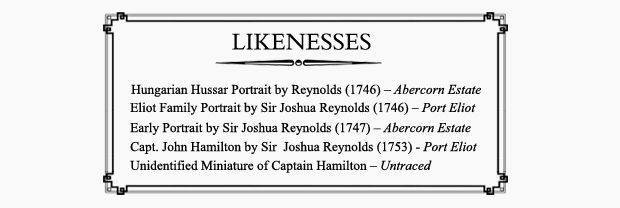
Captain John Hamilton was painted four times by Sir Joshua Reynolds. Two of the portraits are owned by the Abercorn Estate, and two of the paintings hang at Port Eliot.
There is a Miniature Picture of the Captain mentioned in the will of his stepdaughter, Catherine Eliot, bequeathed to the Captain's posthumous son, John James Hamilton (8th Earl of Abercorn).
